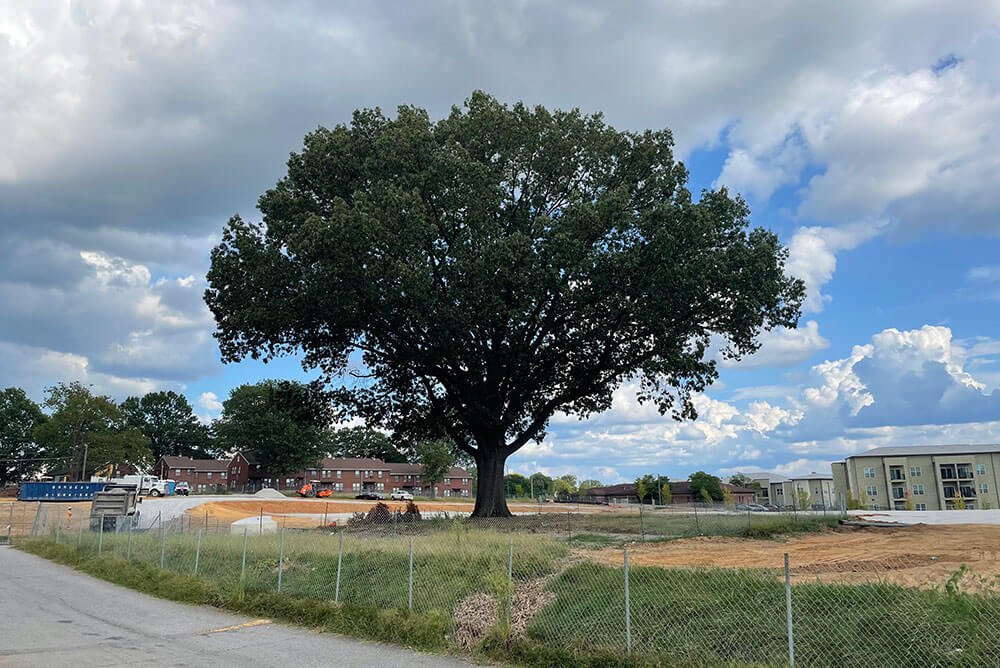How Urban Trees Reduce Air Pollution
Big Green Air Filters
Trees are excellent at cleaning up air pollution, and they are important infrastructure in urban areas. Nashville officially recognized this in 2020, when the Metro Council passed an ordinance requiring that trees be planted along sidewalks in densely developed parts of the city. Not only are trees necessary in public spaces, but the trees in our yards also play a major role in cleaning the air, since much of a city’s canopy is located on private property. That means every tree you decide to plant and care for is a real contribution to managing air pollution in Nashville.
Nashville sits in a geographic bowl, the Nashville Basin, where air pollutants can be trapped, particularly when winds are lighter. Vehicle exhaust, power plants, factories, construction dust and wildfires all contribute to the problem here. Though air pollution in Nashville is generally classified at an acceptable level, occasional spikes can occur. For example, the organization IQAir reports, “In March 2021, Nashville experienced PM2.5 [particulate] readings as high as 42 μg/m3 (nearly 4 times the WHO’s annual PM2.5 target).” These spikes can cause human health issues, including asthma attacks.
A single mature tree can remove 400 pounds of carbon dioxide from the air each year.
One mature tree can remove 0.2 tons (400 pounds) of carbon dioxide (CO2) per year. This figure doesn’t include the other main pollutants that are released by cars and industrial activities, such as carbon monoxide (CO), nitrogen dioxide (NO2) and sulfur dioxide (SO2). These gasses collect in the atmosphere and result in smog and ozone, which are toxin-rich air concentrations that can cause asthma, bronchitis and other lung diseases in humans. As it happens, trees make good use of these molecules as well, further reducing air pollution.
How Trees Improve Air Quality
Trees absorb and capture particles in the air through their leaves, acting as a physical filter for molecules that can damage our bodies, but which trees can use efficiently to grow. Trees use carbon to grow wood and leaves, and nitrogen, sulfur and other molecules to make and store energy. When CO, CO2, NO2 and other pollutants are absorbed by trees and other plants, a biochemical process divides the oxygen from the other molecules and releases it back into the air. The oxygen released as a gas and as water vapor contributes to diluting the air as a consequence of filtration.
Active filtration is an important mitigation tactic in managing air pollution, but it’s not the only way that urban trees affect air quality. Tree crowns are physical barriers to heavier molecules that fall from the atmosphere onto the ground. The leaves collect dust and solid particles that build upon them, which then get rinsed away with rain.
Using all vertical layers of the understory, different sized trees capture falling particles along the way down, and dense shrubs and evergreens act as barriers that can block the horizontal spread of pollutants. They also slow down the wind, which interrupts the spread of dust and pollutants across an area. Trees keep an area slightly more humid, and soil more stable, further slowing the ability of fine particles to spread horizontally by air.
Another way that the canopy’s physical barrier affects air quality is by casting shade and lowering temperatures. In conjunction with raising the immediate area’s humidity, the cool cover that a tree’s crown provides reduces the dangerous formation of ground-level ozone concentrations. High temperatures create more ozone, which is formed when UV rays from sunlight create a gaseous chemical reaction with the pollutants released by cars and other industrial emissions. As ozone builds, it absorbs more UV heat, raising the ambient temperature even more.
Tree leaves collect dust and other particulates from the atmosphere.
Emissions and Distribution
When planning to plant trees for air quality improvement, scientists consider two factors to focus on: the “sources” and the “sinks.” In general, “sources” release carbon pollutants into the atmosphere and “sinks” absorb them. The relationships between these is essential in deciding how to intervene with the most effective solutions. Planting trees along road corridors, for example, is important as an intervention that captures as much pollution as possible at the site and mitigates horizontal spread.
High-traffic areas, however, shouldn’t be covered at the top since this can hold too much pollution near the ground where people are driving, walking or residing. In this case, it’s actually preferable (or less directly dangerous) for the particles to be released vertically to disperse into the atmosphere, where they are diluted by spreading out in the air and processed by the climate’s water cycle, of which trees are a fundamental part. That is, of course, unless they can be captured at the source, or the point of release.
The open atmosphere is one of many environmental sinks — the places where dispersed pollution is absorbed. A tree canopy is another one, and good coverage of our yards, parks and other grounds provides an important filter and shield from falling pollution particles. The less pollution that builds up near the ground, the fewer humans and wildlife will breathe in the toxins.
Trees like this majestic Elm in East Nashville are important factors in controlling urban air pollution.
How You Can Contribute to Mitigating Air Pollution
Private property owners and governments alike have important roles to play in making sure our city’s tree cover is widespread, robust and able to make a significant impact on our local environment and climate. To learn more about what kinds of trees would be best to plant in your yard to contribute to our neighborhood canopies, reach out to us! You can also subscribe to our newsletter to stay up to date on tree news and tips for tree care.



